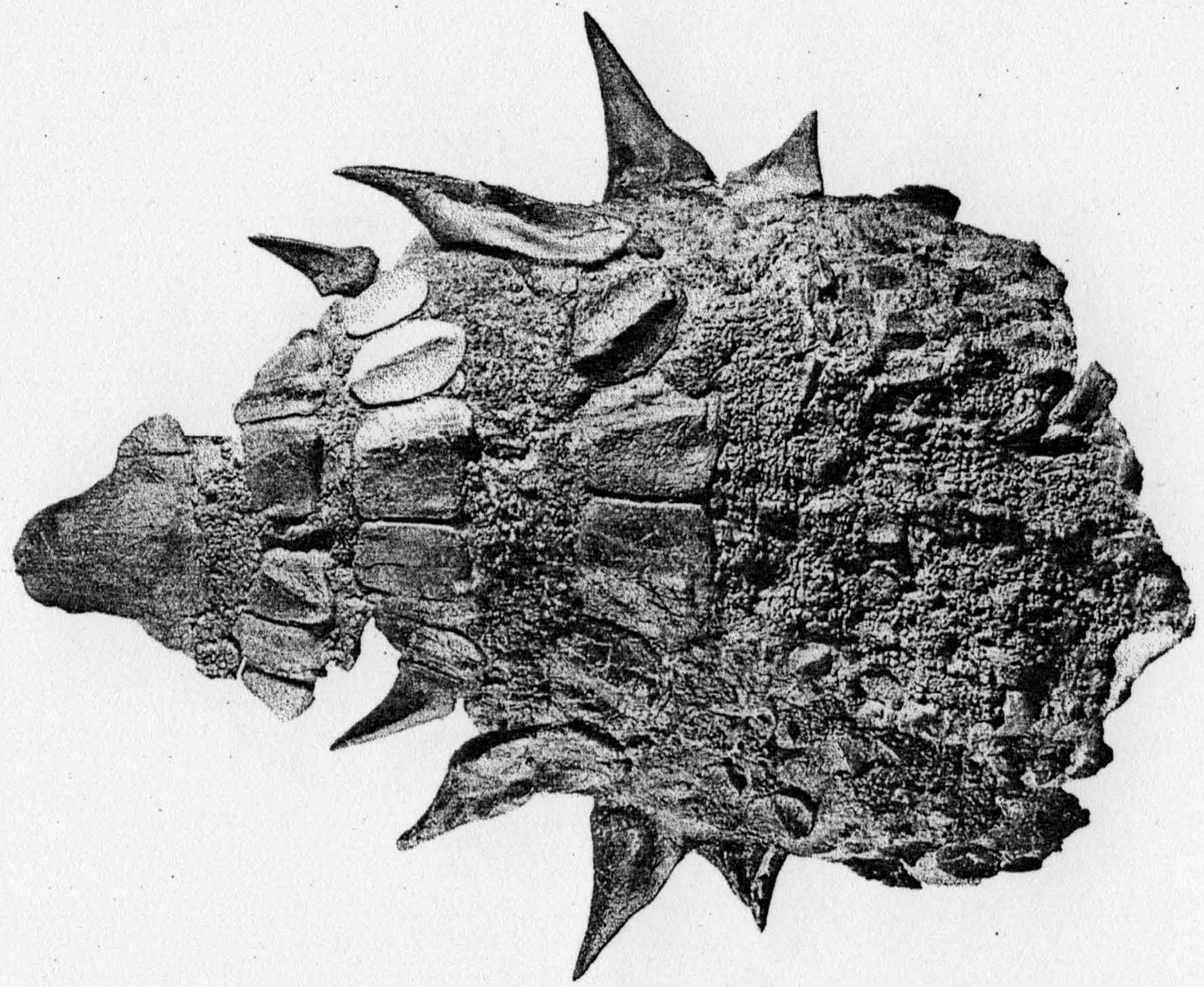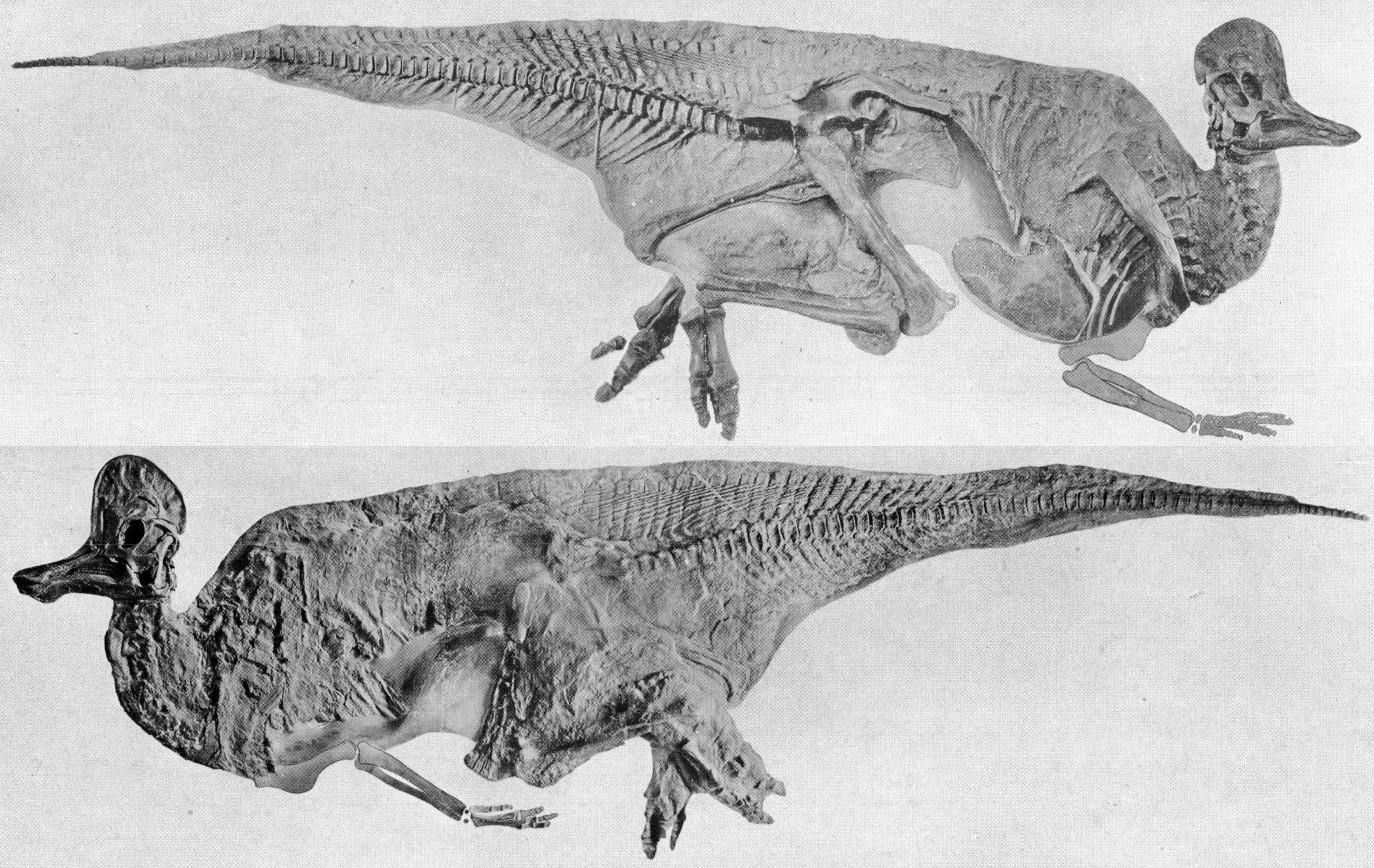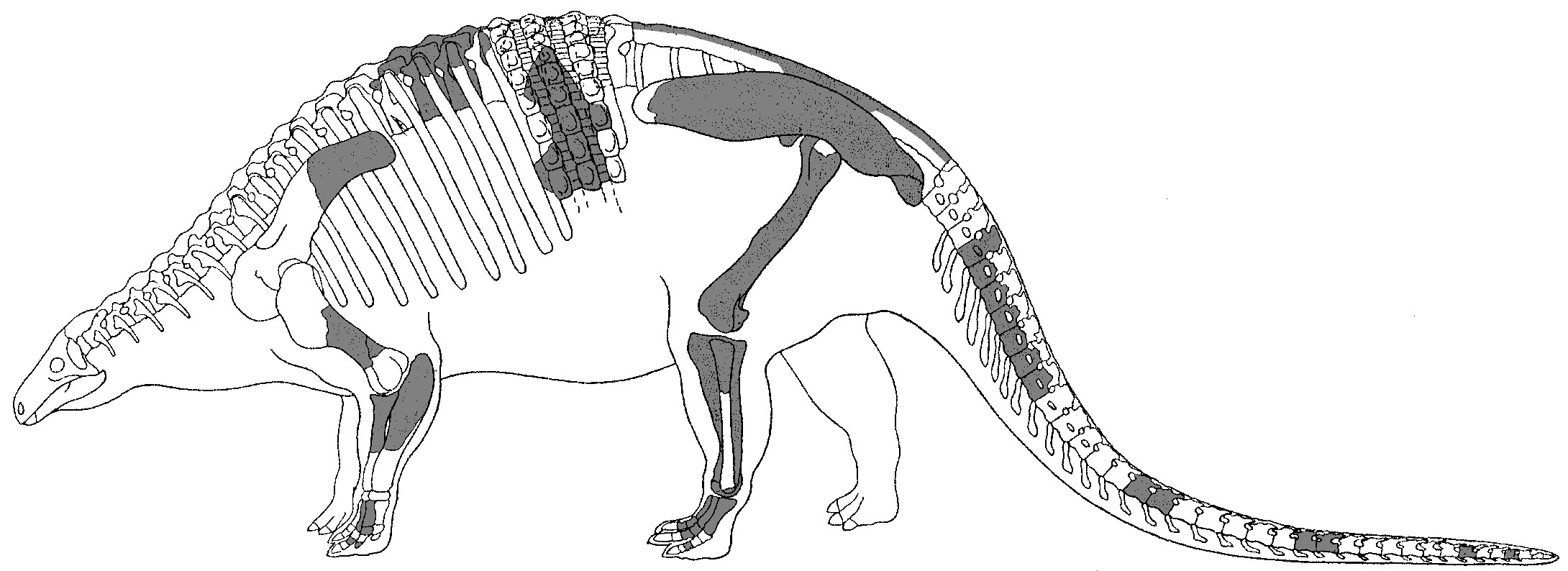|
Panoplosaurus
''Panoplosaurus'' is a genus of armoured dinosaur from the Late Cretaceous of Alberta, Canada. Few specimens of the genus are known, all from the middle Campanian of the Dinosaur Park Formation, roughly 76 to 75 million years ago. It was first discovered in 1917, and named in 1919 by Lawrence Lambe, named for its extensive armour, meaning "well-armoured lizard". ''Panoplosaurus'' has at times been considered the proper name for material otherwise referred to as ''Edmontonia'', complicating its phylogenetic and ecological interpretations, at one point being considered to have existed across Alberta, New Mexico and Texas, with specimens in institutions from Canada and the United States. The skull and skeleton of ''Panoplosaurus'' are similar to its relatives, but have a few significant differences, such as the lumpy form of the skull osteoderms, a completely fused shoulder blade, and regularly shaped plates on its neck and body lacking prominent spines. It was a quadrupedal animal, ... [...More Info...] [...Related Items...] OR: [Wikipedia] [Google] [Baidu] |
Nodosauridae
Nodosauridae is a family of ankylosaurian dinosaurs known from the Late Jurassic to the Late Cretaceous periods in what is now Asia, Europe, North America, and possibly South America. While traditionally regarded as a monophyletic clade as the sister taxon to the Ankylosauridae, some analyses recover it as a paraphyletic grade leading to the ankylosaurids. Description Nodosaurids, like their sister group the ankylosaurids, were heavily armored dinosaurs adorned with rows of bony armor nodules and spines (osteoderms), which were covered in keratin sheaths. Ankylosaurians were small- to large-sized, heavily built, quadrupedal, herbivorous dinosaurs, possessing small, leaf-shaped teeth. Unlike ankylosaurids, nodosaurids lacked mace-like tail clubs and instead had more flexible tail tips. Many nodosaurids had spikes projecting outward from their shoulders. One particularly well-preserved nodosaurid "mummy", the holotype of '' Borealopelta markmitchelli'', preserves a nearly comple ... [...More Info...] [...Related Items...] OR: [Wikipedia] [Google] [Baidu] |
Edmontonia
''Edmontonia'' is a genus of panoplosaurin nodosaurid dinosaur from the Late Cretaceous Period. It is part of the Nodosauridae, a family within Ankylosauria. It is named after the Edmonton Formation (now the Horseshoe Canyon Formation in Canada), the unit of rock where it was found. Description Size and general build ''Edmontonia'' was bulky, broad and tank-like. Its length has been estimated at 6.6 m (22 ft). In 2010, Gregory S. Paul considered both main ''Edmontonia'' species, ''E. longiceps'' and ''E. rugosidens'', to be equally long at six metres and weigh three tonnes.Paul, G.S., 2010, ''The Princeton Field Guide to Dinosaurs'', Princeton University Press p. 238 ''Edmontonia'' had small, oval ridged bony plates on its back and head and many sharp spikes along its sides. The four largest spikes jutted out from the shoulders on each side, the second of which was split into subspines in ''E. rugosidens'' specimens. Its skull had a pear-like shape when viewed from ... [...More Info...] [...Related Items...] OR: [Wikipedia] [Google] [Baidu] |
Dinosaur Park Formation
The Dinosaur Park Formation is the uppermost member of the Belly River Group (also known as the Judith River Group), a major geologic unit in southern Alberta. It was deposited during the Campanian stage of the Late Cretaceous, between about 76.5 and 74.4 million years ago. It was deposited in alluvial plain, alluvial and coastal plain environments, and it is bounded by the nonmarine Oldman Formation below it and the marine (ocean), marine Bearpaw Formation above it.Eberth, D.A. 2005. The geology. In: Currie, P.J., and Koppelhus, E.B. (eds), ''iarchive:dinosaurprovinci0000unse, Dinosaur Provincial Park: A Spectacular Ancient Ecosystem Revealed''. Indiana University Press: Bloomington and Indianapolis, p.54-82. . The Dinosaur Park Formation contains dense concentrations of dinosaur skeletons, both articulated and disarticulated, which are often found with preserved remains of soft tissues. Remains of other animals such as fish, turtles, and crocodilians, as well as plant re ... [...More Info...] [...Related Items...] OR: [Wikipedia] [Google] [Baidu] |
Ankylosaurs
Ankylosauria is a group of herbivorous dinosaurs of the clade Ornithischia. It includes the great majority of dinosaurs with Armour (zoology), armor in the form of bony osteoderms, similar to turtles. Ankylosaurs were bulky quadrupeds, with short, powerful limbs. They are known to have first appeared in North Africa during the Middle Jurassic, and persisted until the end of the Late Cretaceous. The two main families of ankylosaurians, Nodosauridae and Ankylosauridae primarily originated from the Northern Hemisphere (North America, Europe and Asia), but the more basal Parankylosauria originated from southern Gondwana (South America, Australia and Antarctica) during the Cretaceous. Ankylosauria was first named by Henry Fairfield Osborn in 1923.Osborn, H. F. (1923). "Two Lower Cretaceous dinosaurs of Mongolia." ''American Museum Novitates'', 95: 1–1/ref> In the Linnaean classification system, the group is usually considered either a suborder or an infraorder. It is contained within ... [...More Info...] [...Related Items...] OR: [Wikipedia] [Google] [Baidu] |
Ankylosaur
Ankylosauria is a group of herbivorous dinosaurs of the clade Ornithischia. It includes the great majority of dinosaurs with armor in the form of bony osteoderms, similar to turtles. Ankylosaurs were bulky quadrupeds, with short, powerful limbs. They are known to have first appeared in North Africa during the Middle Jurassic, and persisted until the end of the Late Cretaceous. The two main families of ankylosaurians, Nodosauridae and Ankylosauridae primarily originated from the Northern Hemisphere (North America, Europe and Asia), but the more basal Parankylosauria originated from southern Gondwana ( South America, Australia and Antarctica) during the Cretaceous. Ankylosauria was first named by Henry Fairfield Osborn in 1923.Osborn, H. F. (1923). "Two Lower Cretaceous dinosaurs of Mongolia." ''American Museum Novitates'', 95: 1–1/ref> In the Linnaean classification system, the group is usually considered either a suborder or an infraorder. It is contained within ... [...More Info...] [...Related Items...] OR: [Wikipedia] [Google] [Baidu] |
Lawrence Lambe
Lawrence Morris Lambe (August 27, 1863 – March 12, 1919) was a Canadian geologist, palaeontologist, and ecologist from the Geological Survey of Canada (GSC). His published work, describing the diverse and plentiful dinosaur discoveries from the fossil beds in Alberta, did much to bring dinosaurs into the public eye and helped usher in the ''Golden Age of Dinosaurs'' in the province. During this period, between the 1880s and World War I, dinosaur hunters from all over the world converged on Alberta. ''Lambeosaurus'', a well-known hadrosaur, was named after him as a tribute, in 1923. In addition to paleontology, Lambe discovered a number of invertebrate species ranging from Canada to the Pacific Northwest. Lambe's contemporary discoveries were published in works such as ''Sponges From the Atlantic Coast of Canada'' and ''Catalogue of the recent marine sponges of Canada and Alaska''. Early life and education Lambe was born in Montreal on August 27, 1863. Lambe studied at the Roya ... [...More Info...] [...Related Items...] OR: [Wikipedia] [Google] [Baidu] |
Corythosaurus
''Corythosaurus'' (; ) is a genus of hadrosaurid "duck-billed" dinosaur from the Late Cretaceous Period (geology), period, about 77–75.7 million years ago, in what is now Laramidia, western North America. Its name is derived from the Ancient Greek, Greek word κόρυς, meaning "helmet", named and described in 1914 by Barnum Brown. ''Corythosaurus'' is now thought to be a Lambeosaurinae, lambeosaurine, thus related to ''Lambeosaurus'', ''Nipponosaurus'', ''Velafrons'', ''Hypacrosaurus'', and ''Olorotitan''. ''Corythosaurus'' has an estimated length of and has a skull, including the crest, that is tall. ''Corythosaurus'' is known from many complete specimens, including the nearly complete holotype found by Brown in 1911. The holotype skeleton is only missing the last section of the tail and part of the front legs, but was preserved with impressions of polygonal scales. ''Corythosaurus'' is known from many skulls with tall crests that resemble those of the cassowary and ... [...More Info...] [...Related Items...] OR: [Wikipedia] [Google] [Baidu] |
Animantarx
''Animantarx'' ( ; meaning 'living citadel') is a genus of nodosaurid ankylosaurian dinosaur from the Early Cretaceous, Early and Late Cretaceous of western North America. Like other nodosaurs, it would have been a slow-moving quadrupedal herbivore covered in heavy Armour (zoology), armor scutes, but without a ankylosauridae, tail club. The skull measures approximately 25 cm (10 inches) in length, suggesting the animal as a whole was no more than 3 meters (10 feet) long. Discovery and species The generic name is composed of the Latin words ''animatus'' ("living" or "animated") and ''arx'' ("fortress" or "citadel"), referring to its armored nature. In particular, the name is a reference to a comment made by paleontologist R. S. Lull about ankylosaurs, that as "an animated citadel, these animals must have been practically unassailable..." The type species is the only one known so far, and is called ''A. ramaljonesi'' after its discoverer, Ramal Jones. His wife, Carol Jones, ... [...More Info...] [...Related Items...] OR: [Wikipedia] [Google] [Baidu] |
Nodosaurus
''Nodosaurus'' (meaning 'knobbed lizard') is a genus of herbivore, herbivorous nodosauridae, nodosaurid ankylosaurian dinosaur from the Late Cretaceous, the fossils of which are found exclusively in the Frontier Formation in Wyoming. Description ''Nodosaurus'' grew up to roughly long and it was an ornithischian dinosaur with bony dermal plates covering the top of its body, and it may have had spikes along its side as well. The dermal plates were arranged in bands along its body, with narrow bands over the ribs alternating with wider plates in between. These wider plates were covered in regularly arranged bony nodules, which give the animal its scientific name. In 2010 Gregory S. Paul, Paul estimated its length at 6 meters (20 ft) and its weight at 3.5 tonnes (3.85 short tons). It had four short legs, five-toed feet, a short neck, and a long, stiff, clubless tail. The head was narrow, with a pointed snout, powerful jaws, and small teeth. It perhaps ate soft plants, as it ... [...More Info...] [...Related Items...] OR: [Wikipedia] [Google] [Baidu] |






